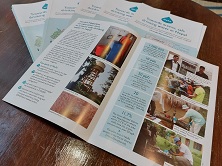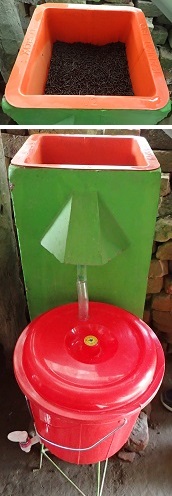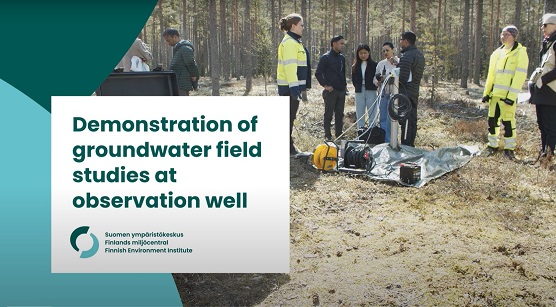
NeAs project brochures © Anu Eskelinen (GTK)
Shortcut: www.syke.fi/projects/neas
NeAs project brochure (pdf, 3780 kB)
As removal report
Video on groundwater field studies in English and in Nepali
Objectives
The aim of this project is to improve the capacity of the water sector in Nepal to seak, share and use the information and know-how on arsenic levels in groundwater and reduction of arsenic in drinking water. The immediate goal of the project is the Improved capacity of DWSSM to guide and support the water supply actors in arsenic mitigation.
Background

Biosand household water filters used in Nepal have a bed of iron nails on top for arsenic removal. © Taina Nystén
Arsenic contamination of groundwater is an environmental health problem in several regions affecting a large number of people, especially in developing countries. In Asian countries unsafe arsenic levels are posing health risk for an estimated 65 million people. Long-term exposure to arsenic from drinking-water and food can cause cancer and skin lesions. The most important action in affected communities is the prevention of further exposure to arsenic by provision of a safe water supply.
In Nepal, the arsenic in groundwater is mainly from geological origin. Arsenic is a natural metalloid element present in the earth’s crust. During the last 25 000 years, rocks rich in arsenic have eroded from high mountain areas of Himalaya through flood and soil erosion and deposited in low lying flood-plain areas in Terai, where arsenic poses a significant risk to groundwater.
The first systematic mapping of arsenic in groundwater was conducted in 1999 in three districts in Terai. In order to create a database on arsenic, a blanket testing was conducted from 2005–2008 in 20 districts of Terai. The blanket testing affirmed that the arsenic contamination of groundwater poses a significant risk to public health in Terai region. The most affected district is Nawalparasi where nearly 12 % of the tube wells have the arsenic concentration over 50 ppb that exceeds the acceptable level for maximum concentrations of arsenic in safe drinking water as defined by WHO, 10 ppb.
The Department of Water Supply and Sewerage Management (DWSSM) under the Ministry of Water Supply is responsible for ensuring safe water services nationwide in Nepal. In 1999, DWSSM has started to implement the arsenic mitigation programme, which has many challenges.
Project preparation
The fact-finding mission to Nepal by Syke’s and GTK’s experts was organized in August 2019 to specify the project idea and the needs and priorities related to arsenic mitigation. During the visit the outline for the project was drafted with DWSSM and WHO. WHO has appointed an advisor for DWSSM in arsenic mitigation since arsenic contaminated drinking water poses a serious health risk.
Project implementation
The project has four main components (Outputs):
- management of arsenic related data and data sharing practices between stakeholders
- conceptual representation of arsenic migration in groundwater together with guidelines and recommendations for the water sector in Nepal
- arsenic monitoring capacities and practices
- communication and awareness raising and increased networking among relevant actors
DWSSM’s capacity for leading arsenic mitigation will be enhanced by promoting data sharing among operators, developing efficient practices for data management and increasing knowledge of geological effects on groundwater quality.
A conceptual model on arsenic migration in typical hydrogeological conditions at NeAs pilot area will be created to increase DWSSM’s capacity to use geological and hydrogeological research data as a basis for decision making. The pilot area in NeAs project is the Parasi district (West Nawalparasi) in the 5. province in Nepal.
NeAs project aims to further improve the quality assurance and quality control of arsenic analysis. The whole chain from field testing and sampling to sample management and laboratory work will be evaluated and tested in cooperation with local operators to update DWSSM’s know-how. The capacity building efforts are based on side-by-side training in the field, on-the-job training and preparing material for training-of-trainees.
A plan for DWSSM’s arsenic related communication will be prepared for raising citizens and decision makers awareness on harmful health effects of the arsenic contaminated groundwater and on functional risk mitigation measures.
Best practices will be collected in NeAs project to form an operating model which can later be used at other areas in Nepal for avoiding the use of arsenic contaminated groundwater for water services.
Main publications
Report on arsenic removal
Ali Mchayk, Taina Nystén, Arati Shrestha, Sirkku Tuominen & Narayan Prasad Acharya. 2023. Review of Arsenic Removal Methods in Water Supply and A Case Study of Predesign Cost Estimation in Nepal. Reports of the Finnish Environment Institute 3/2023. 58 p.
- This report reviews the efficiencies and limitations of arsenic oxidation techniques, conventional technologies (coagulation-flocculation, membrane filtration, adsorption-ion exchange) along with application of nano-particle adsorbents.
- The influence of the water composition on arsenic removal efficiencies is addressed, along with the most important parameters to consider when choosing the best available technology for arsenic removal.
- Arsenic treatment technologies generate arsenic bearing residuals, which can be managed by using several techniques presented in this review.
- As well as, this report provides tools for the cost effectiveness and environmental evaluation of different treatment systems, according to the capital costs, operational costs, and the environmental impact of greenhouse gas emissions and arsenic disposal.
Video on groundwater field studies

Cover of the video on groundwater field studies © Kai Widell
Demonstration of groundwater field studies at observation well (in English)
Demonstration of groundwater field studies at observation well (in Nepali)
The video demonstrates measuring the groundwater level and purging the observation well, and groundwater quality measurements. Also, the video shows how the samples are taken with submersible pump and with bailer, and how the samples are processed during the sampling for anion and metal analyses.
The demonstration took place in May 2023 in Hanko, Finland.
More information
- The Consortium of Project, Geologist Anu Eskelinen, Geological Survey of Finland GTK, firstname.lastname@gtk.fi
- Project coordinator in SYKE, Senior Research Scientist Sirkku Tuominen, Finnish Environment Institute SYKE, firstname.lastname@syke.fi
- Focal point in Nepal,Senior Divisional Engineer Purna Prasad Upadhyay, Department of Water Supply and Sewerage Management DWSSM, rimalpurna[at]gmail.com
- Other coordinators in the project, Taina Nystén (SYKE) firstname.lastname@syke.fi and Jussi Ahonen (GTK) firstname.lastname@gtk.fi